|
|
||||
|
Published by : PROFESSIONAL MEDICAL PUBLICATIONS |
||||
|
ISSN 1681-715X |
||||
|
||||
|
- |
||||
|
ORIGINAL ARTICLE |
||||
|
- |
||||
|
Volume 22 |
July - September 2006 |
Number 3 |
||
|
|
||||
|
|
||||
|
|
||||
|
Published by : PROFESSIONAL MEDICAL PUBLICATIONS |
||||
|
ISSN 1681-715X |
||||
|
||||
|
- |
||||
|
ORIGINAL ARTICLE |
||||
|
- |
||||
|
Volume 22 |
July - September 2006 |
Number 3 |
||
|
|
||||
|
|
||||
Family Medicine Residency Program in
Kingdom of Saudi Arabia: Residents Opinion
Khalid A. Bin Abdulrahman1, Ahmed Al-Dakheel2
ABSTRACT
Background & Objectives: Medical Education continues to improve the outpatient settings; the future of both family physician and specialty of family practice will depend entirely on the quality of care which the patients receive. The initial stage of this process is its effective residency and periodical evaluation of the program. Therefore, this study attempts to explore the residentís views about their training experiences in family medicine clinical attachment and community medicine course.
Methods: Questionnaire based study was conducted in family medicine training centers across the six cities representing all the regions of the Saudi Arabia. Questionnaire consists of family medicine clinical attachment & community medicine course, 139 trainees formed the sample size.
Results: About 85% of the residents believe that they should have a half day clinical attachment in family medicine training center every week throughout the whole program, 43% claimed that they do not have enough time for case discussion with their supervisor. Forty percent residents were not closely supervised by full time trainer; 60% believe that they were treated as service residents rather than trainees in family medicine. In addition, 64% stated that their training centers do not carry video camera facilities for training purposes and 74% believe that the community medicine course should be run by family medicine and community medicine trainers rather than community medicine alone. Furthermore, 50% prefer intergrated course rather than block system and 59% believe that the easily accessible facilities were available such as library, internet, audio-visual aids and 42% thought that their centers were not supported by enough numbers of full time trainers.
Conclusion: The results of this study indicated that, it is the time to evaluate the curriculum of Saudi family medicine training program. Based on the residentís believes, immediate actions have to be taken to improve the clinical supervision, provide enough and qualified trainers for clinical teaching and evaluate the training centers and its ability to be optimal training centers rather than service centers.
Key words: Family Medicine, Residents attitude, Saudi Arabia.
Pak J Med Sci July - September 2006 Vol. 22 No. 3 250-257
1. Dr. Khalid A. Bin Abdulrahman
Department of Family Medicine,
College of Medicine,
King Khalid University Hospital, Saudia Arabia.
2. Dr. Ahmed Al-Dakheel
Consultant Family Physician,
Riyadh Military Hospital,
Riyadh, Saudia Arabia.
Correspondences:
,Dr. Khalid A. Bin Abdulrahman,
Vice-Dean, Post Graduate and CME,
College of Medicine,
King Khalid University Hospital, King Saud University,
P.O. Box 2925, Riyadh - 11461,
Saudia Arabia.
E-Mail: khalidab@ksu.edu.sa
INTRODUCTION
Family practice and other primary care residency programs represents one of medical educationís most significant interfaces with public, social, and health care policy development. These training programs establish, by their number of residency positions, how family physicians (or other primary care physicians) will be available in the future. They also determine, through the type and location of the residency positions, where those residents will practice after graduation and whether those graduate residents will help mitigate the nationís health manpower shortage.
Till the year 1399H. (1979.), health services in the Kingdom of Saudi Arabia (KSA) were delivered in terms of (i) curative care through a network of hospitals and dispensaries, (ii) preventive care through a health offices and to some extent through maternal and child health centers (MCH).1 In response to the need for comprehensive, cost-effective and cost- benefit services, the health care system of Saudi Arabia has witnessed major changes since the early 1980s. This followed governmental commitment to the Alma Ata (USSR) declaration in1978 that stated (Primary Health Care) is the key to attain Health for All (HFA). The fourth and fifth year development plans (1985-1990) in Saudi Arabia have put great emphasis on primary health care (PHC) development within the country.2
Currently, in Saudi Arabia there are over 1700 PHC centers belonging to the Ministry of Health (MOH), these centers are spread all over the country .In addition there are 100 PHC centers run by other various health care providers , including universities.3
Postgraduate training in family medicine is essential for the staffing and development of PHC health care. In Saudi Arabia, the commitment of the MOH to the Alma Ata declaration coincided with the development of postgraduate training in family medicine. In 1981, King Faisal University (KFU) invited international and regional experts in family and community medicine to develop a postgraduate training program relevant to family physicians in Saudi Arabia. These programs include the Arab Board of Family Medicine, which is a degree granted under the Arab Board of Medical Specialties, King Saud University (KSU)Fellowship and the Saudi Board. They began in 1988, 1992 and 1995 respectively.4,5 Residents can enroll in one or more of these programmes simultaneously, but remain under the supervision of the Saudi Council for Health Specialties through its scientific board of family and community medicine. Currently, there are eight family medicine training centers for the Arab and Saudi Boards in Saudi Arabia, these are accredited by the Saudi Council for Health Specialties (SCHS) as training sites for the Saudi Board in Family Medicine.6 Evaluations of trainees in the above fellowships and board programs include continuous assessment through logbooks, proctorsí reports and mock examinations. The Arab Board has only a final exit examination at the end of the three years of training, while all the others have end-of-course examinations. Saudi Board of Family medicine is four years, first and second year the trainee takes rotations in Family Medicine (four months), pediatric (four months), Medicine (6months), Obs / Gyn (three months) Emergency (two months) and surgery (three months). Third year trainee will take rotations in Psychiatry (three months), Community Medicine (three months), Dermatology (one month), ophthalmology (one month), ENT (one month) and two months for electives rotation. The fourth year trainees will take a Family Medicine Clinical attachment Course. There are two major examinations, midway and final, and each has a written component (multiple choice questions and patient management problems with or without structured essays.6 To produce a competent family physician, residency programs should primarily aim at developing primary health care skills.7 Postgraduate trainee doctors are receiving increasing attention, as it is perceived that excessive levels of stress may cause dissatisfaction, low morale and poor work performance.8 There is relationship of medical traineesí stress to the clarity of goals and the level of standards of hospital management, medical team organization, consultant supervision, education and feedback.9
The optimal family medicine program cannot be achieved by unhappy or unsatisfied residents. A cross sectional study conducted by Essam10 shows that majority (72.2%, 69.6%) of trainees are dissatisfied from their rotations in medicine11, and pediatric and this was similar in some studies in United Kingdom and was forcefully expressed by many trainees and educationists in PHC.12 Yaman and Ozen13 showed that postgraduate family medicine curriculum needs to be changed and opinions of residents regarding their training should be taken into consideration. To expand the programmes, emphasis should be placed on improving training sites and using multiple qualitative techniques to assess them, including participant observation, use of focus groups, long interviews and analysis of key texts.14
Since the introduction of Saudi family medicine program in 1995, its assessment has not been made either qualitatively or quantitatively. Apart from the assessment of the program, the views and expressions of its residents, towards family medicine clinic rotation, training center, the community medicine course and other related issues are also important, in order to make periodical changes in the program.
The present study aims to explore the residentís opinions and experience about their Family Medicine clinical attachment, which might help the program director and the authorities to improve the quality of family medicine training program.
SUBJECTS AND METHODS
This study was conducted under the supervision of the department of Family Medicine, College of Medicine, King Khalid University Hospital, King Saud University, Riyadh. A descriptive questionnaire was distributed in family medicine training centers across the six cities (Riyadh, Jeddah, Madina Al-Munawarah, Tabouk, Al-Khobar and Khamees Musheet, representing the central, west, north, east and south regions respectively. The study sample size constitute all trainees (about 139), who were registered with Saudi Council for Health Specialties as family medicine resident, including all residency levels. The opinions and experiences of residents were collected through a well structured questionnaire. It contained 36 items divided into four parts, first part contained demographic data , second part was inquiry for family medicine clinic rotation, third part asked about community medicine rotation and fourth part for primary health care educational training center, the questions inquired on the factors that reported by focus group discussion with a sample of residents and factors reported in literature to influence resident satisfaction with the training program rotations in family medicine clinics, community medicine course and the training center. Participants were asked to rate their agreement and disagreement with a statement by marking 5 points scale from strongly agree to strongly disagree. A pilot study was conducted to standardize the questionnaire. Permission was taken from the concerned authorities to collect the information from the residents.
Data analysis: The data was analyzed by using EPI-info program. The responses to the five-point scale was amalgamated into 3 categories (agree, disagree and undecided) for presenting the results.
RESULTS
The questionnaire response rate was 80% (111 out of 139 trainees), from the eight centers across the KSA. The resident characteristics and their distribution of training level is given in Table-I. Among the trainees, 59% of them had 1-4 clinic per week, 17% had 8-10 clinic per week, whereas 24% of trainees had 5-7 clinic per week. 61% of trainees were treated as services resident rather than trainee in family medicine. 40.4% of trainees felt that they were not closely supervised by full time trainer comparing to 36.5% who were supervised by full time trainer (Table-II).
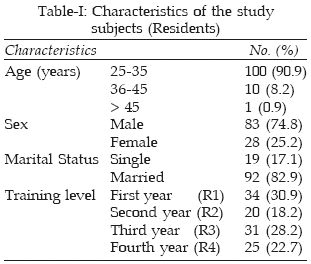
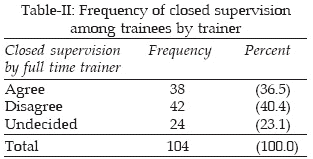
Table-III shows that a higher proportion 84.9% of trainees believes that all family medicine residents should have a half day clinical attachment in family medicine training center every week throughout the whole program while 13.2 % disagreed. Table-IV represents the available facilities which were easily accessible in the training center, 58.9% of trainees agreed that training center facilities were available and easily accessible (e.g. library, internet, audio visual aids) whereas 31.8% disagreed.
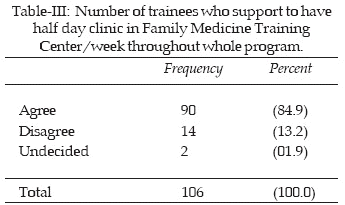
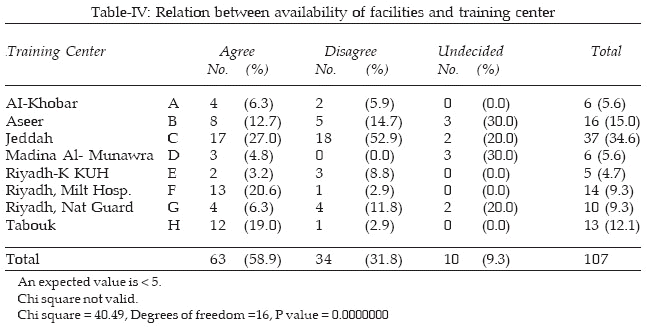
About 42.9% of trainees felt that they have not enough time for case discussion with supervisor and 32.4% had enough time. A higher proportion 64.2% of residents reported that a video camera was not available in their training center. About 60.2% of the residents felt that the program supports them to attend scientific meetings. The assessment method of traineeís performance during family medicine clinical attachment course was fair as experienced by 52.8% of the residents, whereas 23.6% of them disagreed about the fairness of assessment method. About 50% of trainees believe that integrated community medicine course throughout the program will be much better than current block system, compared to 21.7% who disagreed. A higher proportion 73.9% of trainees were of the opinion that the community medicine course (CMC) has to be run by family medicine and community medicine trainer rather than community medicine alone. About 41.8% of residents felt they did not have enough supporting trainers compared to 39.1% who agreed to have enough trainers. 68.2% of residents agreed that, in their current training center, they got exposed to a variety of common patientís problems, compared to 21.8% residents who disagreed (Table-V). A higher proportion 89.2% of residents expressed that, they recommend their center for new residents (Table-VI).
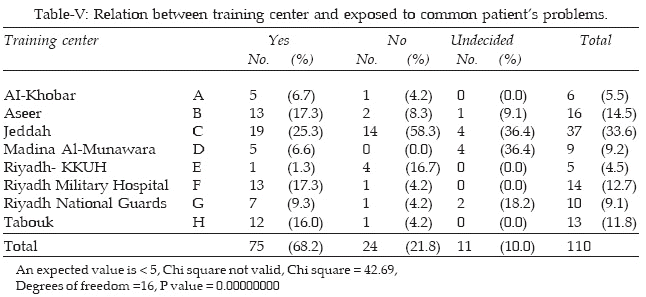
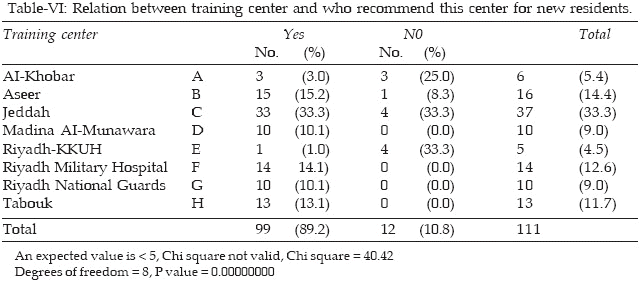
As regards suggestions for improvement of family medicine clinical attachment course, 33.3% of the residents felt to have enough trainers with close supervision and 23.5% wanted more academic activities, whereas 9.8% suggested to improve the training standards of trainers (Table-VII).
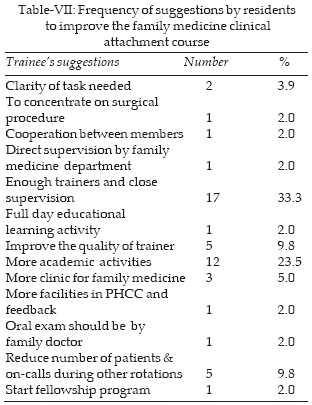
DISCUSSION
The effective family physician brings a unique set of qualities and skills to a practice setting, keeps these up to date, and applies them by using the patient-centered clinical method to maintain and promote the health of patients in his or her practice. The standards of accreditation of training programs in family medicine are based on the effective teaching of the basic principles of family medicine. Scheduling daily resident clinics in the Family medicine training center increased continuity among patients who frequently saw residents beyond that achieved using traditional scheduling, without increasing total resident time in the family medicine center.15 The residents flet that, there was insufficient number of clinics per week/per residents that were taken in most of family medicine training centers compared to program in other countries. In addition there was defect in close clinical supervision, availability of trainers and number of trainers in each training center. An acceptable clinical teaching is concerned with providing role models for good practice, making good practice visible and explaining it to trainees. This is the very basis of clinicians as professionals and should be the foundation for further development of clinicians as excellent clinical teachers.16 The family practice setting provides the opportunity for close supervision and assessment of the residentís abilities through frequent consultation between the resident and the preceptor during the day and through daily chart review discussions. If either the resident or the patient has concerns, the preceptor should be consulted directly. Each resident progresses through training at a different speed. The close one-on-one supervision available in a family practice setting allows cultivation of the residentís strengths, as well as identification of any weaknesses. The sooner areas of weakness are identified, the easier it is to focus on strengthening those areas during training.16 Many residents felt that, they were not supervised directly and had supervision by those trainers who have no interest in clinical teaching. David Cottrell17 found direct supervision and the quality of the supervisory relationship are key to effective supervision. There is a need for clear guidance on supervision the establishment of appropriate procedures and mechanisms to resolve difficulties relating to inadequate supervision for trainees and performing trainees. Insufficient number of supervisors have received training in supervision, though the clinical supervision relationship is valuable for the development of good practice.18 The residents need clinic per week throughout the whole program , especially in the first year(R1), second year (R2) and third year (R3), they were in rotations in other departments without clinic in their training center. With this, they may not apply the principles of family medicine, consultations models and also not having their own patients with follow up. Barry Weiss,19 found that many family medicine educators have called for changing the family practice residency curriculum from a series of block rotations to a longitudinal curriculum. A longitudinal curriculum is one in which residents are based in the family practice center every day during all the three years of their residency training. Residents learn most of the clinical content of family medicine through experiences with patients from their continuity clinics, under supervision of family medicine faculty, rather than through specialty-specific block rotations supervised by specialists. An important benefit of longitudinal training is improved continuity of care between residents and their patients. Unfortunately, definitions of longitudinal training vary widely, and at least one study shows that supposedly longitudinal curricula do not result in better continuity of care. There is some evidence that acquisition of knowledge by residents may be better with intensive block rotations than with longitudinal training. Thus, the supposed benefits of longitudinal residency training remain unproven.19 That is, for many clinics per week throughout the whole program but one clinic per week was applied in Canadian family medicine program for many years, and it was successful even though the length of the program is just two years, but our program is for four years, which might give us more reasonable cause to apply it . The services is a part of training but must be accompanied with enough number of clinics (not too much clinics per week or overload with patients number) with good clinical supervision by trainer, otherwise it will be service program rather than training program. The assessment method of clinical attachment must be fair and that can not be achieved without good clinical supervision. Video camera is important part in education especially in the assessment of consultations, majority of training centers were not having this facility, as reported by our residents. Video assessment of GPs in daily practice according to the procedures described is a valid and reliable method, one which is useful for education and quality improvement. There is a trade-off between feasibility on one hand and validity, reliability and credibility on the other hand. Compared to investments in observation methods in standardized settings, the costs of video observation of GPsí actual performance are acceptable.20 Assessment for quality improvement of family physiciansí practices by video observation in daily practice is superior to video assessment in a simulated setting using standardized patients.21 Towards the Community medicine course introduction as one block (3 months) during the program in the third year (R3), majority of our trainees prefer it to be introduced as integrated course by both, family and community physician rather than community physician alone, the trainees perception must be considered in curriculum planning. As 68.2% of trainees were exposed to variety of common patientís problems, which implies that the position of training centers are good for teaching. And 89.2% of trainees agreed that they recommend their center for the new residents. But lack of supervision with less number of clinics was one of the deficiency of the program as experienced by our residents.
CONCLUSION AND
RECOMMENDATIONS
Like any other study, this study with its own limitations and with its descriptive results, provides an opportunity to Family medicine residency committee of KSA to evaluate and make appropriate changes in the curriculum. Based on the residents opinions, the author recommends the following measures:
(1) Improve the clinical supervision.
(2) To maintain one half day clinic in family medicine training center per week throughout whole program.
(3) Provide enough and highly motivated trainers for clinical teaching and supervision.
(4) Evaluate the training centers and its ability as optimal training centers.
(5) Evaluate the current assessment method during the program.
(6) Reformulate the community medicine curriculum.
REFERENCES
1. Al Marroa YY. Principle and practice of Primary Health Care in Saudi Arabia 1410H (1990G) First Edition, Hilal Pub. Saudi Arabia.
2. The fifth health plan (1410-1415H): current medical situation. (In Arabic) Riyadh, Ministry of Health, Planning Department, 1988:1-20.
3. Annual Health Report, Ministry of Health, Riyadh, Saudi Arabia, 1995.
4. The curriculum of the King Faisal University fellowship training programme in family and community medicine, 3rd ed. Riyadh, King Faisal University Press, 1994.
5. The manual for training in family medicine. (In Arabic) Riyadh, Saudi Council for Health Specialties, 1996.
6. Albar AA. Twenty years of family medicine education in Saudi Arabia, East Meditr Health Journal 1999;5(3):589-96.
7. Rivo ML, Satcher D. Improving access to health care through physician workforce reform. Direction for the 21st century. JAMA 1993; 270:1074-8.
8. Garrud P. Counseling needs and experience of junior hospital doctors. BMJ 1990; 300:445-7.
9. Waleed A, Brian D, Clifford A. Recognizing stress in Postgraduate Medical Trainees. Annals of Saudi Medicine 2000; 19: 182-6.
10. Al Ghamdi EA. The perception of PHC trainees in KSA on their hospital vocational training in medicine and pediatric. Unpublished study.
11. Bayley TJ, the hospital component of vocational training for general practice. BMJ 1994; 308:1339-40.
12. Kearley K. An evaluation of the hospital component of general practice vocational training. BJGP 1990; 40; 409-414.
13. Yaman H, Ozen M, Satisfaction with family medicine training in Turkey: survey of residents, Croat Med J 2002; 43(1): 54-7.
14. Bakram JM. Evaluating family practice residencies: a new method of qualitative assessment. Family Medicine 1997; 29(9): 640-7.
15. Jon O, Bakram JM. Evaluating family practice residencies: a new method of qualitative assessment. Family Medicine 1997; 29 (9): 640-7.
16. Rourke J. Practical tips for rural family physicians teaching residents. Fam Med 2001; 33 (10): 771-5.
17. Cottrell D, Kilminster S, Jolly B, Grant J; What is effective supervision and how does it happen? A critical incident study, Med Edu 2002; 36 (11): 1042.
18. Hadfield D, Clinical supervision: users perspectives, J Child Health Care 2000; 4(1):30-4.
19. Weiss BD, Longitudinal Residency Training in Family Medicine: Not Ready for Prime Time. Fam Med 2001; 33(10):762-5.
20. Ram, Grol, Rethans, Schouten, Vleuten, Kester, Assessment of general practitioners by video observation of communicative and medical performance in daily practice: issues of validity, reliability and feasibility Med Edu 1999; 33 (6): 447.
21. Ram P, Vleuten CV, Rethans JJ, Grol R, Aretz K, Assessment of practicing family physicians: comparison of observation in a multiple-station examination using standardized patients with observation of consultations in daily practice, Acad Med 1999; 74: 62-69.
HOME | SEARCH | CURRENT ISSUE | PAST ISSUES
Professional
Medical Publications
Room No. 522, 5th Floor, Panorama Centre
Building No. 2, P.O. Box 8766, Saddar, Karachi - Pakistan.
Phones : 5688791, 5689285 Fax : 5689860
pjms@pjms.com.pk